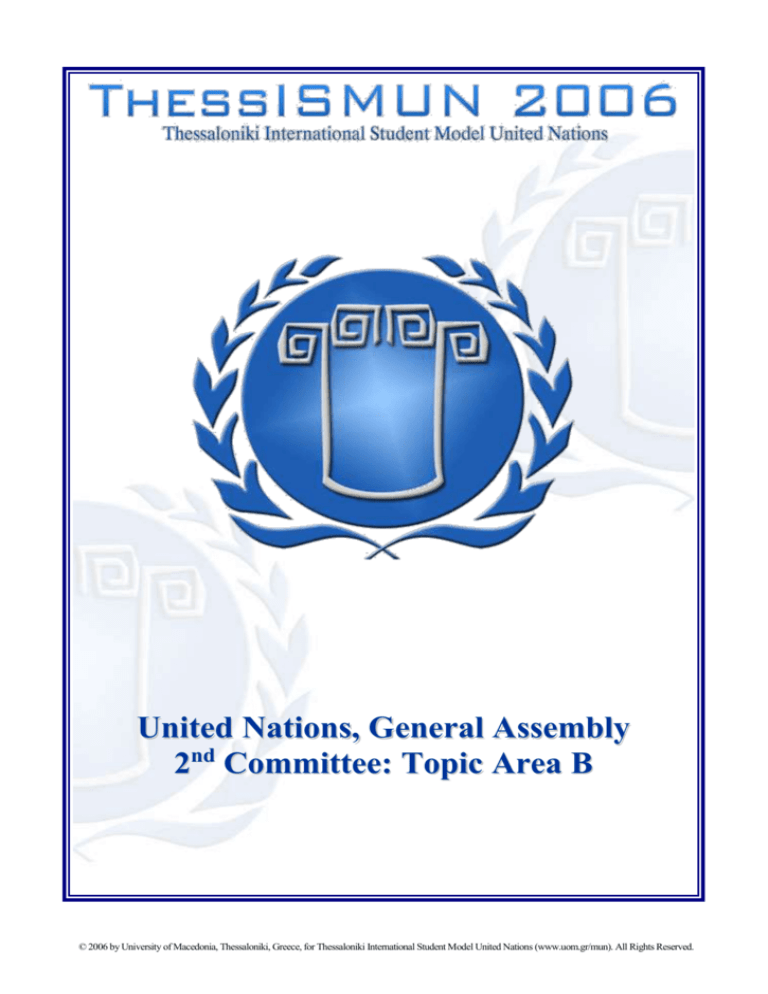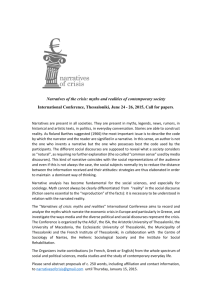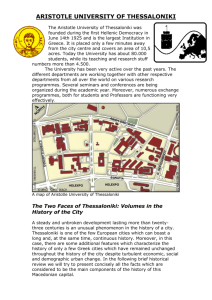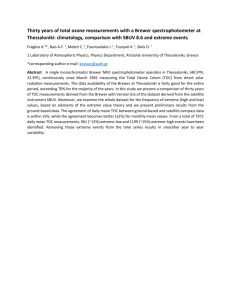
United Nations, General Assembly
2nd Committee: Topic Area B
© 2006 by University of Macedonia, Thessaloniki, Greece, for Thessaloniki International Student Model United Nations (www.uom.gr/mun). All Rights Reserved.
THE FLIGHT OF HUMAN CAPITAL:
MAKING THE “BRAIN DRAIN” THE “BRAIN GAIN”
Statement of the Problem
Intellectuals, professionals, and highly educated students often leave their countries of origin
and take with them their human, or intellectual, capital, a term economists use to describe the
intangible training and skills contained within a person. This loss of human capital, the “brain drain
“, can cause the long-term economic, social and cultural stagnation of developing countries.
What can be done to help encourage development and retention of educated workers? While
taking individual countries’ needs and educational make-up into account, the international
community has a large stake in aiding developing countries to strengthen their domestic work pools,
and must devise suggestions or possible solutions to the problem of the brain drain.
History and Discussion of the Problem
The following sections draw heavily upon the work done by Professor B. Lindsey Lowell, of
Georgetown University and the Pew Hispanic Centre in Washington D.C., on the 46 of the
International Migration Papers, entitled, “Some Developmental Effects of the International
Migration of Highly Skilled Persons.” Figures 1-6 that follow are from that work. As that paper is
an extensive analysis of past studies and all available information in the area of the “Brain Drain”, it
is highly recommended that delegates examine that work in further detail for a more complete
understanding of the topic.
What is the “Brain Drain”?
The term “Brain Drain” refers to the economic loss caused by the emigration of highly educated
and highly skilled workers from developing countries. The increase in skilled emigration from
developing countries was heightened by immigration polices in developed countries which attract
highly skilled workers, particularly in the information and communication technology sector.
Developed countries, such as the United States, Canada, Australia, Ireland, England, Germany, and
others, stand to benefit from the contributions of highly educated foreign workers.
United Nations, General Assembly: 2nd Committee – Topic Area B
Page 2
© 2006 by University of Macedonia, Thessaloniki, Greece, for Thessaloniki International Student Model United Nations (www.uom.gr/mun). All Rights Reserved.
The basic pathology of the brain drain is quite simple. In a developing source country, the
highly skilled population is significantly smaller than that of the developed receiving country while
at the same time those in the highly skilled population are most likely to emigrate.
Any possible negative consequences for the receiving country, such as increasing labour market
competition, are significantly less than those for the source-developing country.
The brain drain phenomenon is not limited to typical developing countries: in the 1990s, the UK
and Ireland had high levels of emigration abroad, and the UK was the world leader, for a time, in
the number of professionals emigrating to the U.S. In addition, over half of the European student
body studying in the US in the science and engineering fields remain in the US after graduating.
Canada also loses many to the United States, but does replace its losses with highly skilled
foreigners from developing countries in Asia. While developed countries are not invulnerable to the
same types of brain drain losses as less developed nations, the negative effects of the movement of
the tertiary or highly skilled, worker are much more pronounced in the developing countries.
Demography of the Brain Drain
Analyzing the effects of the Brain Drain is difficult. The only comparative data set which can
determine the negative effects of the drain was constructed in 1998, with data only for the year
1990. Furthermore, the authors of the study, Carrington and Detragiache, could only estimate their
numbers for Africa, Asia and the Pacific, North, and South America by the percentage of highly
educated persons from a given developing country who migrate to OECD countries. Effects for
developing Eastern European countries were compared in a different study by Straubhaar and
Wolburg, using the percent of emigrants from a developing country who are highly educated. Both
studies focus on the tertiary educated population, what is often considered to be the “college
educated.”
There are two ways of measuring the numerical effects of the brain drain migration.
“Cumulative loss” refers to the percent of all term educate emigrants from a particular country base
upon tit e tot tertiary educated population from that country (i.e. # of emigrants/ (# of emigrants + #
of non-migrants of same educational category). “Educational selectivity” of the emigrant flow
United Nations, General Assembly: 2nd Committee – Topic Area B
Page 3
© 2006 by University of Macedonia, Thessaloniki, Greece, for Thessaloniki International Student Model United Nations (www.uom.gr/mun). All Rights Reserved.
refers to the degree to which emigrants tend to be highly educated (i.e. # of tertiary educated
emigrants / total # of emigrants from all educational categories). Each method highlights different
aspects of the brain drain and the two should be considered in tandem. In addition, one can create
“regional averages” against which to gauge individual countries.
These measures can allow us to paint some interesting pictures. In terms of cumulative loss,
figure 2 reveals that the tertiary educated population loss far exceeds that of the secondary (high
school) educated in every region except South America. Furthermore, the percentage loss is greatest
in North America, where about 15 percent of all highly skilled persons in this region are found in an
OECD country. In terms of educational selectivity Figure 3 reveals a high level of tertiary education
among emigrants, the highest of all the regions, with over 70 percent. Asia and the Pacific follow,
with just over 50 percent; South America just under that; Eastern Europe with 20 percent; and North
America just under that figure.
Figure 4 rank orders the countries whose share of the tertiary educated emigrants abroad
exceeds the regional average. Jamaica comes in the highest with an estimated 77 percent of its
tertiary population abroad. Figure 5 rank orders countries with emigrant educational selectivity
higher than the regional average. Additionally this graph displays the percentages for Eastern
Europe, which happen to be comparatively lower than those for other regions, but it also reflects the
distribution of percentages also found in figure 3; figure 4 seems to do the same for those in figure
2.
It is important to note that the countries with the greatest cumulative population losses of its
tertiary educated are not necessarily those with the greatest educational selectivity. Countries that
appear on both lists merit particular attention.
United Nations, General Assembly: 2nd Committee – Topic Area B
Page 4
© 2006 by University of Macedonia, Thessaloniki, Greece, for Thessaloniki International Student Model United Nations (www.uom.gr/mun). All Rights Reserved.
Figure 6 reveals how much of the respective numbers of tertiary educated emigrants are in the
United States. It is worthy of note that nearly all of the tertiary emigrants from North America and
much of those from South America find their way to the U.S. It is also intriguing that only two
countries, Egypt and South Africa, account of 75 percent of the total tertiary outflows in Africa.
Emigrants from Asia comprise about half of the tertiary immigrants in the U.S. and about two-thirds
of those in the OECD. The graph clearly demonstrates that while the numeric loss of highly skilled
persons might be large, the relative loss to the source country is not as great; indirectly, it also
validates the opposite: the numeric loss of tertiary skilled persons may not be huge, but the relative
loss to the source country is sizeable.
Economic Considerations of the Brain Drain
The early brain drain literature of the 1960s voiced no reason for concern; global welfare
increases due to the rational choice of highly skilled emigrants seeking improved income abroad.
Later revision to neoclassical economic development models, however, engendered convictions of
the adverse affect of the brain drain on developing countries; in short, the brain drain slows
economic (GDP) growth and impinges on the progress of those who remain in the developing
United Nations, General Assembly: 2nd Committee – Topic Area B
Page 5
© 2006 by University of Macedonia, Thessaloniki, Greece, for Thessaloniki International Student Model United Nations (www.uom.gr/mun). All Rights Reserved.
country -- mainly low skilled workers. Thus, poverty and inequality are expected to increase along
with the drain.
Recently, a new “endogenous growth theory” model has generated the same type of expectation,
but with a much larger projected loss than that of the neoclassical models. Capital investment and
productivity may well deteriorate while the incentives for emigration to more advanced economies
increases. Moreover, this deterioration reduces the wages of the unskilled population and increases
the wages of the skilled workers who remain, increasing inequality as well.
Interestingly enough, there is the possibility that tax- supported education in source countries
may accelerate the brain drain. Domestic tertiary workers will choose to emigrate to earn more
abroad, and thus, those who fill in the gaps left behind may not be as productive. As such,
governments may loose more of their investment in education than before.
Another intriguing idea is the notion of an “optimal brain drain.” While large scale exodus of
tertiary workers will potentially drain the pool of skilled workers faster than it can be replenished,
United Nations, General Assembly: 2nd Committee – Topic Area B
Page 6
© 2006 by University of Macedonia, Thessaloniki, Greece, for Thessaloniki International Student Model United Nations (www.uom.gr/mun). All Rights Reserved.
complete closure of emigration can also have adverse effects. The possibility of emigration is
important to the balance of incentives; higher returns for skills in a foreign country encourage
acquisition of education and skills in the source country; which then in turn increases the average
human capital, which subsequently stimulates overall source country economic growth. Despite the
sweeping effects of the brain drain, it is also evident that the actual long term harmful effects are as
unique to the particular country as are the original problems that led to the brain drain in the first
place; thus the influence of institutional factors in the individual countries requires a case-by-case
analysis of the direct effects of the brain drain.
Feedback Effects and Offsetting Factors
One offsetting effect of the consequences of the brain drain is the potential for return migration,
which in addition to re-supplying the tertiary population in the source country can also increase
average country productivity, technology transfer, the injection of new ideas and investment in the
home country by the physical return of expatriates, also occurs. Many argue that these technology
transmissions are more important than the reintegration of the people themselves.
Additionally, research on international migration flows suggests that they are associated with an
increase in international trade between a developing country and the developed industrial country
that is also the receiving country for the other country’s emigrants. While this educational factor has
yet to be analyzed in detail, the suggested trade link between source and receiving countries seems
to be born out in studies.
United Nations, General Assembly: 2nd Committee – Topic Area B
Page 7
© 2006 by University of Macedonia, Thessaloniki, Greece, for Thessaloniki International Student Model United Nations (www.uom.gr/mun). All Rights Reserved.
Another factor which might mitigate the effects of the brain drain, meaning emigrant monetary
remittances (i.e. sending portions of wages earned in a foreign country back to family members in
the home country), has often been referred to as potential catalysts for economic growth. Although
such remittances may temporarily compensate for brain drain losses, there has been little evidence
that they change the underlying effects. In fact, it is probable that those in the tertiary educated
population of emigrants are less likely to remit than those in the lesser skilled population and thus it
is doubtful that the actual total remittances can offset the total economic loss of the source country
due to the brain drain.
Some Conclusions and One Proposed Solution
Unfortunately, much of the previous work done on the flight of human capital depends upon
assumptions—theoretical and economic models— which, while mathematically sophisticated and
marginally supported by empirical data, remain assumptions. Empirical analysis and / or the
modelling of statistical data are relatively scarce. Furthermore, feedback effects and offsetting
factors were typically not included in the previous work, making further analysis more difficult.
Given these considerations, a regional and country-by- country analysis seems imperative.
Based upon the data given here, only five countries —Korea, South Africa, Dominican Republic,
Columbia, and Chile — appear to have all three symptoms of the brain drain: above average rates of
cumulative loss of the tertiary educated, above average rates of tertiary educational selectivity in
emigration, and a dominant share of their region’s numeric outflow of tertiary educated persons.
Nevertheless, however the data is portrayed, there is a clear consensus of opinion that the “Brain
Drain” is an enduring problem that must be addressed.
In that respect, one of the many proposed solutions is that of a tax on international human
capital flows. In that source countries could benefit greatly from such a tax as to offset much of the
ensuing brain drain losses. There have been several suggestions as to potential tax schemes and
policy alternatives that would make this possible. As this proposal is lengthy, highly complex and
requires a more sophisticated understanding of economics, further discussion of this plan will not be
found in this study guide. Should one feel inclined to explore this intriguing solution, or any aspect
of the information given thus far in the study guide, please refer to the “Suggestions for Further
Research” section at the end of this study guide.
Previous Programs Addressing the Brain Drain
The earliest international interest in the “Brain Drain” gave rise to U.N. discussions starting in
1967; interest, however, dissipated in the 1980s and only resurfaced again in the late 1990s. It is the
International Organization for Migration (IOM/ OIM), which has done extensive work on the return
of qualified nations to their respective native countries. The following is a list of IOM/OIM
programs that have addressed some aspects of the development problem arising from the flight of
human capital with brief program summaries based upon those on the IOM/OIM website. The
United Nations, General Assembly: 2nd Committee – Topic Area B
Page 8
© 2006 by University of Macedonia, Thessaloniki, Greece, for Thessaloniki International Student Model United Nations (www.uom.gr/mun). All Rights Reserved.
following programs have a smaller- scaled emphasis that may serve as a model for further action on
a lager scale. (As there are many programs of interest, the outcome of each has been left to further
investigation by the individual delegate, should he or she desire to do so.)
Return of Qualified Afghans (RQAFN)
The Return of Qualified Afghans Programme (RQA) will facilitate the effective participation
and active engagement of skilled and qualified Afghan nationals currently residing outside
Afghanistan in the reconstruction, capacity building and development process of their home
country. Those experts will be placed in jobs identified by TOM, in coordination with the Afghan
Interim Administration (AIX), the provincial authorities in the country, and local and international
bodies working in Afghanistan (partner organizations), as critical to the country’s reconstruction
and sustainable development plans. Focusing on particular sectors of Afghan society where local
resources are scarce, the project will enhance the infrastructure necessary to accommodate a larger
scale general return through the transfer of expertise and know-how of qualified Afghan expatriates,
and contribute to the longer-term stability and development of Afghanistan. Those under the project
will be awarded a self-employment grants their own business, in view of generating additional
employment opportunities for the local workforce and returnees.
Partners: UN Regional Coordination Offices (RCOs), WFP, international and national NGOs,
national and local authorities.
Target Group: 500 Qualified Afghan nationals;
Duration: 36 months;
Countries: Iran (Islamic Republic of), Pakistan, Egypt
Return and Reintegration of Qualified Afghan Nationals in the Health and Primary Education
Sectors (RQAFGN)
This project contributes to the reconstruction process in Afghanistan and supports the
rehabilitation program in the health, education and other social service sectors by strengthening the
qualified human resource capacity in Afghanistan. It assists Afghan professionals in Pakistan in
returning to identified jobs in these sectors. IOM provides counselling activities to candidates
willing to return back and referral services to organizations interested in recruiting people, through
the IOM Employment Referral Unit in Peshawar and a database system which to date, consists of
more than 1000 applications from qualified Afghans willing to return.
Partners: NGOs within the health and primary education sectors operating inside Afghanistan.
Target Groups: 200 qualified Afghan nationals (30% female) in the health and primary education
sectors, and their NGO employers.
Duration: 24 months.
United Nations, General Assembly: 2nd Committee – Topic Area B
Page 9
© 2006 by University of Macedonia, Thessaloniki, Greece, for Thessaloniki International Student Model United Nations (www.uom.gr/mun). All Rights Reserved.
Countries: Pakistan, Afghanistan
Reconstruction, Capacity Building and Development Through the Return of Qualified Nationals to
Bosnia (RCDB)
The project will return up to one-thousand qualified / skilled nationals as well as their
immediate dependants to Bosnia and Herzegovina (BiH) from host countries in Europe and North
America. These skilled nationals will in turn contribute to activities in the reconstruction, capacity
building and development process of their home country. They will be placed in jobs identified by
the government and international institutions as critical to the country’s reconstruction and
sustainable development plans, or in job creating self- employment ventures. This will enhance the
infrastructure so that it can accommodate larger-scale general return. The program is implemented
in cooperation with the local Bosnian communities in the host countries as well as in BiH.
Partner: The Ministry of Refugees;
Target Group: 1000 skilled nationals and their dependants
Duration: 4 years
Countries: Bosnia and Herzegovina
Return of Judiciary and Prosecutors to Minority Areas in Bosnia and Herzegovina (RJP)
This project will ease the return and professional reintegration of 50 Bosnian judges and
prosecutors from within Bosnia and Herzegovina. Returning judges and prosecutors will be
provided with housing allowances as long as they are not able to access their pre-war
accommodation. Judges and prosecutors will also have the opportunity to attend training courses at
the Judicial Training Centres before they take up their positions.
Partners: Ministries of Justice in the Federation and in Republika Srpska and their relevant
“Commissions”
Target Group: 50 judges and prosecutors plus their dependants returning to their places of origin
within Bosnia and Herzegovina
Duration: 30 months
Countries: Bosnia and Herzegovina
Research Project for a Return Program for Qualified Cape-Verdians (RQCV)
The objective of this project is to carry out a survey of qualified nationals living abroad, as well
as to identify national human resources needs. Cape Verdian nationals abroad represent an
important source of technical expertise that could be tapped in for the country’s development - one
of the objectives set by the government. The third phase of the Return of Qualified Nationals
United Nations, General Assembly: 2nd Committee – Topic Area B
Page 10
© 2006 by University of Macedonia, Thessaloniki, Greece, for Thessaloniki International Student Model United Nations (www.uom.gr/mun). All Rights Reserved.
project, implemented by IOM between 1996 and 1999, showed clearly the necessity of the Cape
Verdian Government to take into account those qualified nationals living overseas who wish to
contribute to the development of their home country.
Partners: UNDP and the Government of Cape Verde
Target Group: Qualified nationals residing in Cape Verde and target countries
Duration: 7 months
Countries: Senegal
Programme for the Occupational Reintegration of Kosovo Albanians from Belgium (ORK)
As a second phase of the Programme for Return and Reintegration of Kosovo Albanians from
Belgium (RKB), this project aims to assist Kosovo Albanians currently living in Belgium by
helping their successful and sustainable reintegration into their region of origin. The project will
address a comprehensive set of activities comprising the development of the labour market
sustainability and absorption, combined with other support services to returnees such as job
placement counselling and provision of business training.
Partners: The Belgian Ministry for Budget, Social Integration and Social Economy and partneragencies in Belgium and in Kosovo
Target Group: 180 Kosovo Albanians and their family members (540 people in total)
Duration: 6 months
Countries: Belgium, Yugoslavia
Return and Reintegration of Qualified Latin American Nationals (RQNLA)
RQNLA specifically aims to help highly qualified Latin American professionals abroad to
return to their country of origin or to any other country in the region where their qualifications and
experience would be valuable for the developmental process.
Target Group: Qualified nationals and former scholars
Duration: Open-ended
Country: Argentina
Reintegration of Returnees from the Netherlands who have completed a Vocational Training
(RNVT)
This project hopes to contribute to more sustainable returns of rejected asylum-seekers and
other migrants from the Netherlands. Several educational institutions in the Netherlands provide
vocational training to asylum-seekers, awaiting the outcome of their legal asylum-seeking
United Nations, General Assembly: 2nd Committee – Topic Area B
Page 11
© 2006 by University of Macedonia, Thessaloniki, Greece, for Thessaloniki International Student Model United Nations (www.uom.gr/mun). All Rights Reserved.
procedure. The outcome in many cases, however, is negative. Considering these circumstances, the
education centres (ROC) together with the Central Organization for the Receipt and Housing of
Asylum seekers (COA), have indicated that it is important to regard the training not only as a tool
of integration into the Dutch society, but also as a way to smooth the progress of an eventual return.
Within this project (Geschoold Terug: Educated Return), IOM will develop modules on the
issue of return as part of the vocational training in at least 20 groups. Secondly, TOM will develop
individual counselling techniques on return within the context of vocational training for at least 300
individuals.
Thirdly, IOM will assemble all relevant information from the respective countries of origin in
order to focus the vocational training as much as possible with respect to the current situation in
each country of origin.
Partners: Regional Education Centres (ROC), Central Organi2ation for the Receipt and Housing of
Asylum-Seekers
(COA)
Target Group: 300 asylum-seekers residing in the Netherlands
Duration: 12 months
Management of Funds to Transfer Qualified Human Resources and Humanitarian Mobilization
(QHHM)
The objective of this project is to strengthen the capacities of both public and private Peruvian
Universities through the transfer of highly qualified human resources (such as computer
programmers, lecturers and engineers) to priority areas. This will result in the creation of financial
resources for the return and employment of qualified nationals, through the management of funds of
public and private employers.
Target Group: Public and private universities in Peru
Duration: Open-ended
Country: Peru
Return, Reintegration and Development in Somalia (RRDS)
The immediate aim of this project is to return and reintegrate qualified Somali nationals living
in the UK who have applied for asylum and now wish to return to Somalia. The program will be
open to Somali nationals with different asylum status, e.g. asylum-seekers, those granted
‘Exceptional Leave to Remain’ and Convention Status. The project will target the regions in
Somalia where there are conditions conducive for the safe, orderly return. It is expected that the
United Nations, General Assembly: 2nd Committee – Topic Area B
Page 12
© 2006 by University of Macedonia, Thessaloniki, Greece, for Thessaloniki International Student Model United Nations (www.uom.gr/mun). All Rights Reserved.
majority of the returnees will be going to Somaliland and Punt Land. Other returnees wishing to
return to other regions of Somalia will also be considered.
The return and reintegration will be organised on a case-by-case basis. Each returnee will be
assessed and receive assistance from IOM and the implementing partners, thus enabling them to
access the employment market either directly or through training linked to income generating
activities.
Partners: UK Home Office, Refugee Action and NGOs in Somalia
Target Group: 100 Somali nationals living in the UK
Duration: 12 months; Countries: Somalia, I United Kingdom of Great Britain and Northern Ireland
Thai Expert Program (THEP)
The project aims to provide assistance to the Thai National Science and Technology
Development Agency (NSTDA), under the Ministry of Science, Technology and Environment, by
bringing back Thai scientists and technology experts on a temporary basis in an effort to offset the
effects of brain drain in Thailand. The experts will share their knowledge and experience with Thais
in the country in conference, workshop, and seminar form. These activities may result in
cooperative projects between expatriate Thai experts and locals.
Target Group: Public and private sectors in Thailand
Duration: Open-ended
Countries: Thailand, United States of America, Canada, Japan
Return and Reintegration of Qualified Ugandan Nationals: Bridging Phase (RQUGN)
This project is a continuation and extension of the third phase of the Return and Reintegration of
Qualified African Nationals (RQAN) program, which was implemented from January 1995 to
December 31, 1999 under the Lomé IV Convention. The project encouraged highly qualified
Ugandan nationals residing in industrialized countries, as well as other African countries, to return
to Uganda and fill vacant jobs. In order to enhance the sustainability of the program, the project also
assisted and encouraged the Ugandan Government to establish an institutional framework for the
promotion of the voluntary return and reintegration of its highly qualified, qualified and skilled
nationals.
Target Group: 25 qualified and skilled Ugandan nationals and their dependents Duration: 12 months
Country: Uganda
Questions a Resolution Must Answer
United Nations, General Assembly: 2nd Committee – Topic Area B
Page 13
© 2006 by University of Macedonia, Thessaloniki, Greece, for Thessaloniki International Student Model United Nations (www.uom.gr/mun). All Rights Reserved.
Each resolution should include a concise and useful definition of the term “brain drain,” in
addition to a list of its causes and effects. The resolution must then answer three questions about
education reform.
First, what are the desirable types of reforms? What can be done to increase research
opportunities and a revitalization of the current education systems? What types of incentives are
there for indigenous professionals, intellectuals, and students to return? What types of systems or
changes can be made in the governments’ involvement in higher education?
Secondly, how can the committee help to bring about the above changes? Who will pay for
them? Should the international community become directly involved? How might foreign
investment be involved? How do other economic integration organizations factor into addressing
the brain drain? What types of methods are effective in facilitating the return and reintegration of
intellectuals to their native countries?
Finally what is needed in terms of information technology capacity? What sorts for structures
would be best for such a task?
Suggestions for Further Research
Please remember that this study guide is just an overview of the problem. We expect all
delegates to conduct further research. The 46th of the International Migration Papers, entitled,
“Some Developmental Effects of the International Migration of Highly Skilled Persons.” by
Professor B. Lindsey Lowell, from which the first part of this study guide is drawn upon can be
downloaded at http://www.ilo.org/public/english/protection/migrant/download/imp/imp46.pdf. Not
only does it flesh out the barebones sketch outlined here, it can also serve as launching point from
which to conduct further research.
You can also download a full length paper entitled, “Sharing the Spoils: Taxing International
Human
Capital
Flows,”
(Desai,
Kapur,
and
McHale,
2001)
at
http://www.people.hbs.edu/mdesai/dkmwp.pdf. While this study guide has provided summaries of
numerous relevant projects, the IOM/OIM website, http://www.iom.int, may provide other helpful
information and links pertaining to this topic area.
The bibliography at the end of this study guide also contains a compilation of websites and other
sources of interest; they may prove helpful during auxiliary research. This topic may seem daunting
and extensive; however, it is highly relevant and significant to the current development situation in
our modern world. Feel free to send any questions, comments, or concerns to
panos628@hotmail.com; the best of luck in your research and committee preparation!
POSITION PAPERS
Each delegation must submit a position paper (see Position Paper Guidelines in Documentation
page, on ThessISMUN 2006 website) for each topic area, addressing where your assigned country
United Nations, General Assembly: 2nd Committee – Topic Area B
Page 14
© 2006 by University of Macedonia, Thessaloniki, Greece, for Thessaloniki International Student Model United Nations (www.uom.gr/mun). All Rights Reserved.
stands on the issue in question. This position paper has two purposes: first, to focus your research
and preliminary understanding of the material; second, to allow your director a glimpse of your
thoughts and ideas ahead of the conference.
While you will not be held to the letter of the position paper, each delegation is charged with the
responsibility of representing the true interests of their country. Do your best to be accurate; value
coherence and concision over length and detail. The following questions should be addressed in
your position papers:
What is the current development status of your country? Are you a developing source country or a
developed receiving country?
Does your country benefit from the current migration flows, or does it suffer? Both? How so
and why? Identify the positive and negatives effects of the “brain drain” on your country
How would increased levels of education affect your (developing source) country? How would
increase levels or return migration affect your (developing receiving) country? How would you
benefit from an “optimal brain drain?”)
What is our country’s position on an international tax on human capital flows? What solutions
and / or suggestions does your country offer?
It is understandable that the answers to all these questions may not fit on just one page. Do not
become consumed in details; these position papers are meant to help you begin preparation for the
conference. As such, it is imperative that they are turned in on time.
United Nations, General Assembly: 2nd Committee – Topic Area B
Page 15
© 2006 by University of Macedonia, Thessaloniki, Greece, for Thessaloniki International Student Model United Nations (www.uom.gr/mun). All Rights Reserved.
BIBLIOGRAPHY
“International Migration Papers #46: Some Developmental Effects of the International
Migration of Highly Skilled Persons” B. Lindsey Lowell. International Migration Branch,
International
Labour
Office,
Geneva
2001
http://www.ilo.org/public/english/protection/migrant/download/imp/imp46.pdf
“Sharing the Spoils: Taxing International Human Capital Flows” Desai, Mihir. A., Devesh
Kapur, and John McHale. http://www.people.hbs.edu/mdesai/dkmwp.pdf
“The Technological Revolution: What about the Developing Countries?” Sirimanne, Shamika
Canadian
International
Development
Agency
http://www.acdicida.gc.ca/xpress/dex/dex9604.htm
International Organization for Migration http://www.iom.int
Africa
“Algorithms
in
Africa”
Marshall,
Wayne
2001
http://www.linuxjournal.com/article.php?sid=4657
“The Flight of Financial Capital from Africa” 2000 http://emeagwali.com/interviews/capitalflight/africa.hrml
“The Regional Conference on Brain Drain and Capacity Building in Africa” ECA Press Release
No.
01/2000
http://www.uneca.org/eca_resources/Press_Releases/2000_pressreleaseO12000_eng.htm
“Report of the Regional Conference On Brain Drain and Capacity Building in Africa” UN
ECOSOC,
Economic
Commission
for
Africa
(ECA)
http://www.iom.int/africandiaspora/pdf/Braindrain.pdf
(See also http://www.iom.int/africandiaspora/default.htm)
Korea
“Countering
Brain
Drain
Effect”
Wansoon,
http://www.hankooki.com/kt_biz/200103/t2001031217471143110.htm
Kim
2001
Norway
“Strategy for strengthening research and higher education in the context of Norway’s relations
with
developing
countries.”
Ministry
of
Foreign
Affairs,
Norway,
1999
http://odin.dep.no/ud/engelsk/publ/handlingsplaner/032091-990287/index-dok000-b-n-a.html
Russia
“Back to Russia: The human capital returning to Russia from abroad is a source of long-term
economic growth” Guriyev, Sergei 29 January 2002 http://www.cdi.org/russia/ johnson/60499.cfm
United Nations, General Assembly: 2nd Committee – Topic Area B
Page 16
© 2006 by University of Macedonia, Thessaloniki, Greece, for Thessaloniki International Student Model United Nations (www.uom.gr/mun). All Rights Reserved.








